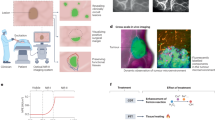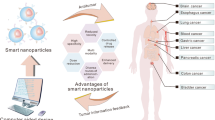Abstract
Magnetic resonance imaging (MRI) and magnetic resonance spectroscopic imaging (MRSI) are evolving techniques that offer noninvasive evaluation of anatomic and metabolic features of prostate cancer. The ability of MRI to determine the location and extent of the tumor and to identify metastatic spread is useful in the pretreatment setting, enabling treatment decision-making that is evidence-based. MRSI of the prostate gland expands the diagnostic assessment of prostate cancer through the detection of cellular metabolites, and can lead to noninvasive differentiation of cancer from healthy tissue. MRI/MRSI can also be used to evaluate both local and systemic recurrence, with endorectal MRI being capable of detecting local recurrence, even in patients with rising serum PSA level but no palpable tumor on digital rectal examination. Considering the benefits that MRI and MRSI have been shown to offer patients, the skills and technology required to perform these tests should be widely disseminated to make their routine use possible. Teamwork between members of radiology, pathology, urology and radiation oncology departments is essential in order to exploit these technologies fully.
This is a preview of subscription content, access via your institution
Access options
Subscribe to this journal
Receive 12 print issues and online access
$209.00 per year
only $17.42 per issue
Buy this article
- Purchase on Springer Link
- Instant access to full article PDF
Prices may be subject to local taxes which are calculated during checkout





Similar content being viewed by others
References
Jemal A et al. (2005) Cancer statistics, 2005. CA Cancer J Clin 55: 10–30
Boring CC et al. (1993) Cancer statistics, 1993. CA Cancer J Clin 43: 7–26
Amling CL et al. (1998) Influence of prostate-specific antigen testing on the spectrum of patients with prostate cancer undergoing radical prostatectomy at a large referral practice. Mayo Clin Proc 73: 401–406
Stamey TA et al. (1998) Classification of localized untreated prostate cancer based on 791 men treated only with radical prostatectomy: common ground for therapeutic trials and TNM subgroups. J Urol 159: 2009–2012
Kaminski JM et al. (2002) Relationship between prostate volume, prostate-specific antigen nadir, and biochemical control. Int J Radiat Oncol Biol Phys 52: 888–892
Zelefsky MJ et al. (2001) High dose radiation delivered by intensity modulated conformal radiotherapy improves the outcome of localized prostate cancer. J Urol 166: 876–881
Beyersdorff D et al. (2002) Patients with a history of elevated prostate-specific antigen levels and negative transrectal US-guided quadrant or sextant biopsy results: value of MR imaging. Radiology 224: 701–706
Yuen JS et al. (2004) Endorectal magnetic resonance imaging and spectroscopy for the detection of tumor foci in men with prior negative transrectal ultrasound prostate biopsy. J Urol 171: 1482–1486
Claus FG et al. (2004) Pretreatment Evaluation of Prostate Cancer: Role of MR Imaging and 1H MR Spectroscopy. Radiographics 24 (Suppl 1): S167–S180
Hricak H et al. (2003) Advances in imaging in the postoperative patient with a rising prostate-specific antigen level. Semin Oncol 30: 616–634
Hricak H et al. (1994) Carcinoma of the prostate gland: MR imaging with pelvic phased-array coils versus integrated endorectal—pelvic phased-array coils. Radiology 193: 703–709
Coakley FV and Hricak H (2000) Radiologic anatomy of the prostate gland: a clinical approach. Radiol Clin North Am 38: 15–30
Hricak H et al. (1987) MR imaging of the prostate gland: normal anatomy. AJR Am J Roentgenol 148: 51–58
Noguchi M et al. (2000) An analysis of 148 consecutive transition zone cancers: clinical and histological characteristics. J Urol 163: 1751–1755
Perrotti M et al. (1999) Prospective evaluation of endorectal magnetic resonance imaging to detect tumor foci in men with prior negative prostastic biopsy: a pilot study. J Urol 162: 1314–1317
Fleshner NE and Fair WR (1997) Indications for transition zone biopsy in the detection of prostatic carcinoma. J Urol 157: 556–558
Liu IJ et al. (2001) Critical evaluation of the current indications for transition zone biopsies. Urology 57: 1117–1120
Engelbrecht MR et al. (2003) Discrimination of prostate cancer from normal peripheral zone and central gland tissue by using dynamic contrast-enhanced MR imaging. Radiology 229: 248–254
van Dorsten FA et al. (2004) Combined quantitative dynamic contrast-enhanced MR imaging and (1)H MR spectroscopic imaging of human prostate cancer. J Magn Reson Imaging 20: 279–287
Ogura K et al. (2001) Dynamic endorectal magnetic resonance imaging for local staging and detection of neurovascular bundle involvement of prostate cancer: correlation with histopathologic results. Urology 57: 721–726
Scheidler J et al. (1999) Prostate cancer: localization with three-dimensional proton MR spectroscopic imaging—clinicopathologic study. Radiology 213: 473–480
Kurhanewicz J et al. (1996) Three-dimensional H-1 MR spectroscopic imaging of the in situ human prostate with high (0.24–0.7-cm3) spatial resolution. Radiology 198: 795–805
Heerschap A et al. (1997) In vivo proton MR spectroscopy reveals altered metabolite content in malignant prostate tissue. Anticancer Res 17: 1455–1460
Zakian KL et al. (2005) Correlation of proton MR spectroscopic imaging with Gleason score based on step section pathologic analysis after radical prostatectomy. Radiology 234: 804–814
Kaji Y et al. (1998) Localizing prostate cancer in the presence of postbiopsy changes on MR images: role of proton MR spectroscopic imaging. Radiology 206: 785–790
Schiebler ML et al. (1993) Current role of MR imaging in the staging of adenocarcinoma of the prostate. Radiology 189: 339–352
Heerschap A et al. (1997) Proton MR spectroscopy of the normal human prostate with an endorectal coil and a double spin-echo pulse sequence. Magn Reson Med 37: 204–213
Coakley FV et al. (2002) Prostate cancer tumor volume: measurement with endorectal MR and MR spectroscopic imaging. Radiology 223: 91–97
Kurhanewicz J et al. (2000) The prostate: MR imaging and spectroscopy. Present and future. Radiol Clin North Am 38: 115–138, viii–ix
Mullerad M et al.: Comparison of endorectal magnetic resonance imaging, guided prostate biopsy and digital rectal examination in the preoperative anatomical localization of prostate cancer. J Urol, in press
D'Amico AV et al. (2000) Endorectal magnetic resonance imaging as a predictor of biochemical outcome after radical prostatectomy in men with clinically localized prostate cancer. J Urol 164: 759–763
Jager GJ et al. (2000) Prostate cancer staging: should MR imaging be used?—A decision analytic approach. Radiology 215: 445–451
Yu KK et al. (1999) Prostate cancer: prediction of extracapsular extension with endorectal MR imaging and three-dimensional proton MR spectroscopic imaging. Radiology 213: 481–488
Engelbrecht MR et al. (2002) Local staging of prostate cancer using magnetic resonance imaging: a meta-analysis. Eur Radiol 12: 2294–2302
Wang L et al. (2004) Prostate cancer: incremental value of endorectal MR imaging findings for prediction of extracapsular extension. Radiology 232: 133–139
Yu KK et al. (1997) Detection of extracapsular extension of prostate carcinoma with endorectal and phased-array coil MR imaging: multivariate feature analysis. Radiology 202: 697–702
Mullerad M et al. (2004) Prostate cancer: detection of extracapsular extension by genitourinary and general body radiologists at MR imaging. Radiology 232: 140–146
Hull GW et al. (2002) Cancer control with radical prostatectomy alone in 1,000 consecutive patients. J Urol 167: 528–534
Catalona WJ et al. (1999) Contemporary results of anatomic radical prostatectomy. CA Cancer J Clin 49: 282–296
Bernstein MR et al. (2000) Endorectal coil magnetic resonance imaging and clinicopathologic findings in T1c adenocarcinoma of the prostate. Urol Oncol 5: 104–107
Naya Y et al. (2003) Volume indexes of total, free, and complexed prostate-specific antigen enhance prediction of extraprostatic disease extension in men with nonpalpable prostate cancer. Urology 62: 1058–1062
Wymenga LF et al. (2001) Routine bone scans in patients with prostate cancer related to serum prostate-specific antigen and alkaline phosphatase. BJU Int 88: 226–230
Harisinghani MG et al. (2003) Noninvasive detection of clinically occult lymph-node metastases in prostate cancer. N Engl J Med 348: 2491–2499
Bellin MF et al. (1998) Lymph node metastases: safety and effectiveness of MR imaging with ultrasmall superparamagnetic iron oxide particles—initial clinical experience. Radiology 207: 799–808
Hovels AM et al. (2004) Cost-analysis of staging methods for lymph nodes in patients with prostate cancer: MRI with a lymph node-specific contrast agent compared to pelvic lymph node dissection or CT. Eur Radiol 14: 1707–1712
Daldrup-Link HE et al. (2001) Whole-Body MR Imaging for Detection of Bone Metastases in Children and Young Adults. AJR Am J Roentgenol 177: 229–236
Algra PR et al. (1991) Detection of vertebral metastases: comparison between MR imaging and bone scintigraphy. Radiographics 11: 219–232
Turner JW et al. (1993) Magnetic resonance imaging for detection of prostate cancer metastatic to bone. J Urol 149: 1482–1484
Eustace S et al. (1997) A comparison of whole-body turboSTIR MR imaging and planar 99mTc-methylene diphosphonate scintigraphy in the examination of patients with suspected skeletal metastases. AJR Am J Roentgenol 169: 1655–1661
Meijer WG et al. (2003) Bone metastases in carcinoid tumors: clinical features, imaging characteristics, and markers of bone metabolism. J Nucl Med 44: 184–191
Traill ZC et al. (1999) Magnetic resonance imaging versus radionuclide scintigraphy in screening for bone metastases. Clin Radiol 54: 448–451
Lauenstein TC et al. (2004) Whole-body MR imaging: evaluation of patients for metastases. Radiology 233: 139–148
Lauenstein TC et al. (2002) Three-dimensional volumetric interpolated breath-hold MR imaging for whole-body tumor staging in less than 15 minutes: a feasibility study. AJR Am J Roentgenol 179: 445–449
Silverman JM and Krebs TL (1997) MR imaging evaluation with a transrectal surface coil of local recurrence of prostatic cancer in men who have undergone radical prostatectomy. AJR Am J Roentgenol 168: 379–385
Sella T et al. (2004) Suspected local recurrence after radical prostatectomy: endorectal coil MR imaging. Radiology 231: 379–385
Nudell DM et al. (2000) Imaging for recurrent prostate cancer. Radiol Clin North Am 38: 213–229
Coakley FV et al. (2004) Endorectal MR imaging and MR spectroscopic imaging for locally recurrent prostate cancer after external beam radiation therapy: preliminary experience. Radiology 233: 441–448
Author information
Authors and Affiliations
Corresponding author
Ethics declarations
Competing interests
The authors declare no competing financial interests.
Rights and permissions
About this article
Cite this article
Huzjan, R., Sala, E. & Hricak, H. Magnetic resonance imaging and magnetic resonance spectroscopic imaging of prostate cancer. Nat Rev Urol 2, 434–442 (2005). https://doi.org/10.1038/ncpuro0296
Received:
Accepted:
Issue Date:
DOI: https://doi.org/10.1038/ncpuro0296
This article is cited by
-
Non-invasively predicting differentiation of pancreatic cancer through comparative serum metabonomic profiling
BMC Cancer (2017)
-
Standardizing the use of functional MRI in prostate cancer
Nature Reviews Urology (2011)
-
The potential for practical improvements in cancer diagnostics by mathematically-optimized magnetic resonance spectroscopy
Journal of Mathematical Chemistry (2011)
-
Synthesis of bombesin-functionalized iron oxide nanoparticles and their specific uptake in prostate cancer cells
Journal of Nanoparticle Research (2010)
-
Unequivocal resolution of multiplets in MR spectra for prostate cancer diagnostics achieved by the fast Padé transform
Journal of Mathematical Chemistry (2009)



